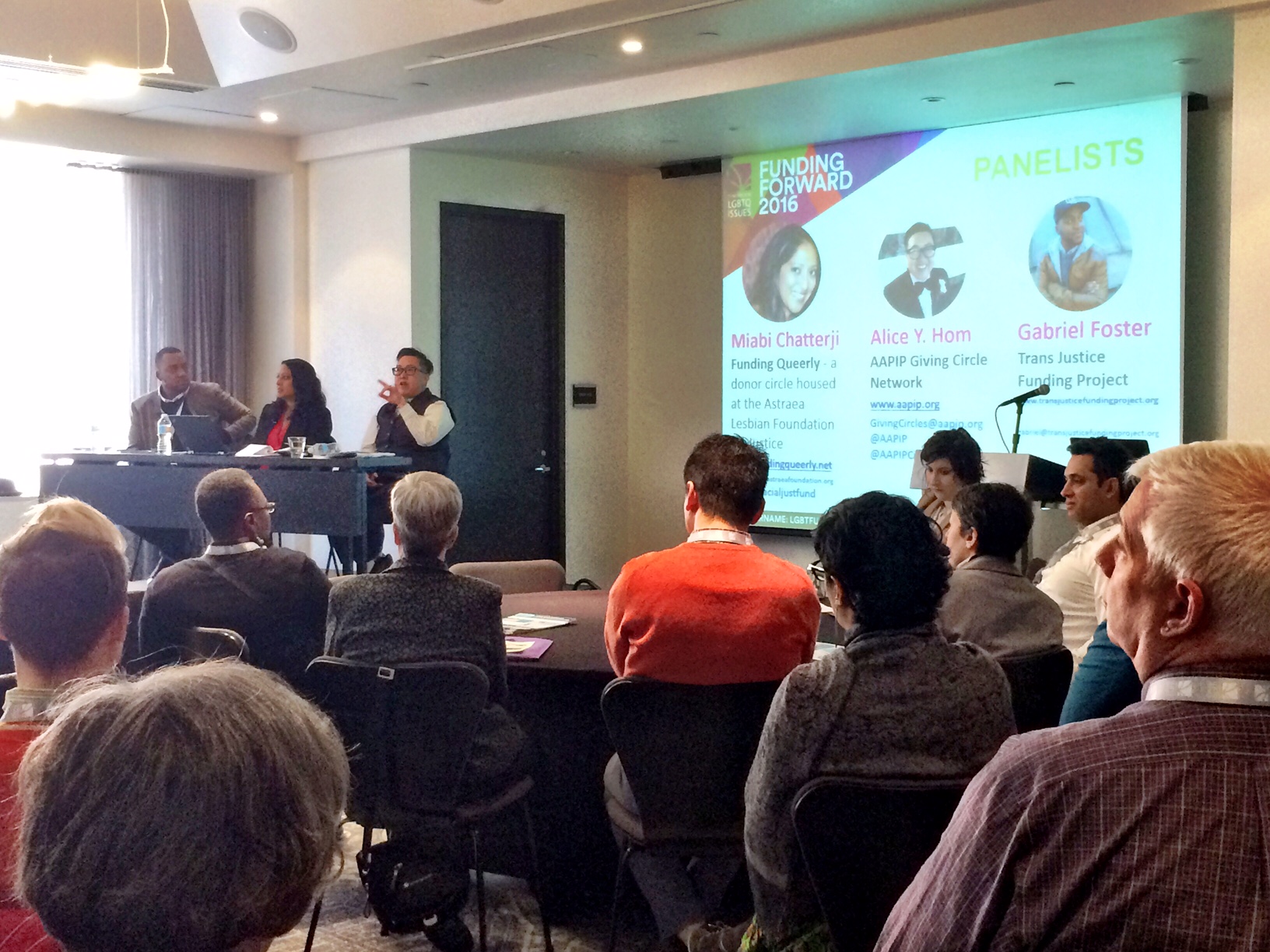by Alice Y. Hom
Institutional philanthropy and foundations have limitations, methods, and criteria that don’t always meet the needs of under-resourced communities. Indigenous, low-income, people of color, rural, transgender, and young LGBTQ communities face barriers to accessing institutional philanthropy and resourcing their self-led activism. Given these barriers, people have gotten resourceful!
It’s high time to amplify the discussion on alternative funding models and how under-resourced communities have always been sustaining themselves without the financial support of philanthropic institutions. One place where this conversation happened recently was at Funders for LGBTQ Issues’ Funding Forward conference in Minneapolis.
We held a workshop about our resilient communities that have creatively come up with their own solutions to address the lack of funding for LGBTQ and people of color communities. Miabi Chatterji, a member of the Funding Queerly Giving Circle that is hosted at the Astraea Lesbian Foundation for Justice, shared how a group of young donors under the age of 40 created this circle to support small community organizing groups. Gabriel Foster, a founder of the Trans Justice Funding Project (TJFP), talked about how TJFP provides grants to groups and projects that don’t have 501(c)3 status or aren’t fiscally hosted, which helps grassroots groups and projects who don’t have access or don’t want to become a part of the nonprofit industrial complex. I talked about AAPIP’s Giving Circle Campaign and how there are 5 LGBTQ AAPI giving circles in the network of 50 giving circles. All together, our panel on alternative funding models highlighted the following: grantmaking decisions should be made by community members and those most impacted by the issues; small grants between $1000-$5000 can have a big impact on grassroots groups and projects; and individuals who support giving circles and alternative funding vehicles see the importance of funding at the intersections of identities and political issues. All of these are typically not how foundations work, which is why it’s crucial to have these other giving models.
 In terms of AAPIP’s Giving Circle Network, we’ve seen the impact of sharing information on the LGBTQ AAPI issues and the lack of institutional philanthropy to LGBTQ AAPI communities. While the total amount for LGBTQ funding from foundations in 2014 was $153.2 million, which is less than one percent of total foundation funding, only $911,339 went to LGBTQ AAPI communities and projects. These dismal figures helped activate individuals to create LGBTQ AAPI giving circles—Red Envelope Giving Circle, Rainbow Dragon Fund, the Dinner Guys, Lacuna Giving Circle, and API LGBTQ Dream Team and they have given out $102,518 to LGBTQ AAPI communities in the San Francisco Bay Area, Washington DC, New York, and Los Angeles over the past 5 years. Additionally, Ally giving circles in AAPIP’s network have also supported LGBTQ AAPI organizations and projects to the tune of $96,311 over the past 5 years. Overall, AAPIP’s Giving Circle Network has invested over 7% of its funding to LGBTQ AAPI communities, totaling $198,829. We want to increase this number and will be working closely with our LGBTQ AAPI and Ally giving circles.
In terms of AAPIP’s Giving Circle Network, we’ve seen the impact of sharing information on the LGBTQ AAPI issues and the lack of institutional philanthropy to LGBTQ AAPI communities. While the total amount for LGBTQ funding from foundations in 2014 was $153.2 million, which is less than one percent of total foundation funding, only $911,339 went to LGBTQ AAPI communities and projects. These dismal figures helped activate individuals to create LGBTQ AAPI giving circles—Red Envelope Giving Circle, Rainbow Dragon Fund, the Dinner Guys, Lacuna Giving Circle, and API LGBTQ Dream Team and they have given out $102,518 to LGBTQ AAPI communities in the San Francisco Bay Area, Washington DC, New York, and Los Angeles over the past 5 years. Additionally, Ally giving circles in AAPIP’s network have also supported LGBTQ AAPI organizations and projects to the tune of $96,311 over the past 5 years. Overall, AAPIP’s Giving Circle Network has invested over 7% of its funding to LGBTQ AAPI communities, totaling $198,829. We want to increase this number and will be working closely with our LGBTQ AAPI and Ally giving circles.
AAPIP is well aware of the impact of its community philanthropy and how a collective of individuals can and do make a big difference to our under-resourced communities. Please contact us to learn more about how you can make a difference for our communities: GivingCircles@aapip.org
